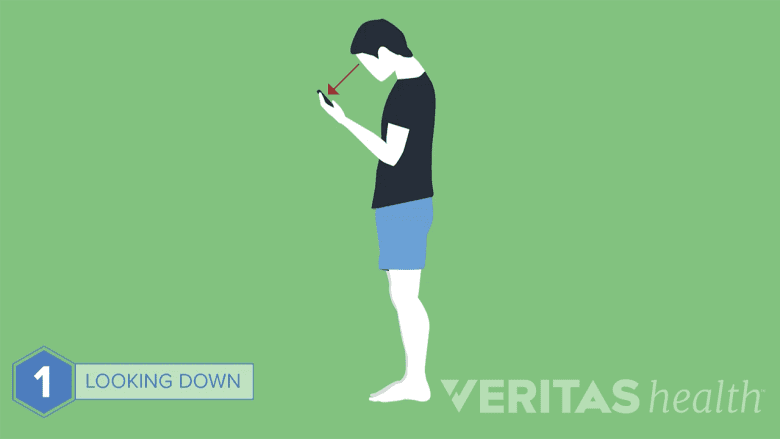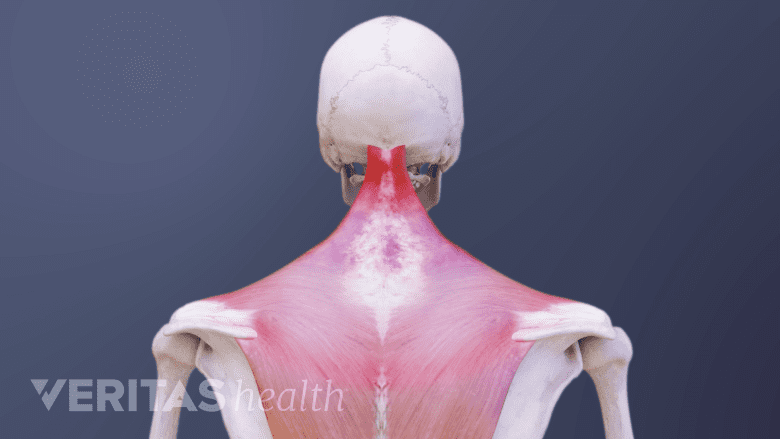Text neck describes a repetitive stress injury or overuse syndrome in the neck, caused by prolonged use of mobile devices with the head bent downward and not moving. Also called tech neck, text neck is commonly associated with texting, but it can be related to many activities performed on phones and tablets while looking downward, such as surfing the web, playing games, or doing work.
In This Article:
- How Does Text Neck Cause Pain?
- Text Neck Symptoms and Diagnosis
- Text Neck Treatment and Prevention
- Text Neck Symptoms and Causes Video
- Text Neck Treatment Video
Head’s Weight Magnified
Texting requires bending the head forward and looking down, putting significant strain on the neck.
The weight of the head is a key factor for text neck pain. The neck’s muscles, tendons, and ligaments are meant to support the head’s weight—10 to 12 pounds—in a neutral position balanced atop the cervical spine. When texting on a phone, it is common to bend the head forward and look down at a 45- or 60-degree angle, which places about 50 to 60 pounds of force on the neck.1Hansraj KK. Assessment of Stresses in the Cervical Spine Caused by Posture and Position of the Head. Surgical Technology International. 2014;11(25):277-9. The neck is not able to withstand this amount of pressure over a prolonged period.
The Course of Text Neck
Text neck begins as mild ache in neck/upper back, may show as sharp pain or stiffness.
Text neck typically begins as a relatively mild ache in the neck or upper back. It could also present with sharp pain or stiffness in the neck. When text neck is suspected of causing pain, it is typically treated with a combination of:
- Limiting phone/tablet use to necessary tasks
- Using better posture by holding devices up closer to eye level
- Performing exercises and stretches that specifically target the neck, chest, and upper back
If not addressed, the continued forward head posture and hunched shoulders may worsen over time, which could lead to even more pain and reduced mobility in the neck, upper back, and shoulders.
See Forward Head Posture’s Effect on Neck Muscles
In some cases, the excessive forward head posture may exacerbate or accelerate degenerative conditions in the cervical spine, such as cervical degenerative disc disease and/or cervical osteoarthritis.
Unique Risks of Smartphones and Tablets to Stress the Neck
When the head is tilted forward, it can put additional strain on the neck.
Here are some reasons why smartphone and tablet use may pose some unique risks to stress the spine:
- Severe neck angle to view the screen. Compared to TVs and personal computers, smartphone and tablet screens are more commonly viewed while flat on a table or lap, which means the screen angle is more severe. As such, the neck and head are typically bent further forward to view smartphones than other screens.
Touchscreen element may bring shoulders and head further forward. Research in the journal Ergonomics found that study participants had more forward head posture while texting compared to other smartphone tasks, such as web browsing or watching a video.2Lee S, Kang H, Shin G. Head flexion angle while using a smartphone. Ergonomics. 2015;58(2):220-226. One possible reason may be that texting is more likely to involve the use of both hands as well as more time with the fingers touching the screen, which is more likely to require the shoulders to round forward even further.
Some other activities, such as reading a printed book or washing dishes, also prompt people to tilt their heads, but the difference may be that people use smartphones and tablets for a much longer time and are less likely to shift positions.
Watch Text Neck Symptoms and Causes Video
Impact on Growing Spines Still Being Studied
There is special concern about the potential health impact on teenagers—among the most frequent text message users—whose spines are still developing. Many doctors, chiropractors, and other medical professionals have reported seeing an increase in neck pain and poor posture among teenage patients due to frequent texting and mobile device use, but thus far the evidence is mostly anecdotal.3Cuéllar JM, Lanman TH. "Text neck": an epidemic of the modern era of cell phones?. Spine J. 2017;17(6):901-902.
While holding the head forward for long periods of time is widely recognized in the medical community as a risk factor for neck pain, there is some debate as to how much of a factor smartphone and tablet use plays in neck pain and poor posture in teens and young adults. While a study of young adults in Sweden found a link between texting time and neck pain, the results appeared stronger in the short-term rather than the long-term.4Gustafsson E, Thomee S, Grimby-Ekman A, Hagberg M. Texting on mobile phones and musculoskeletal disorders in young adults: a five-year cohort study. Appl Ergon. 2017; 58(1):208-14. doi: 10.1016/j.apergo.2016.06.012 Also, a study of 18- to 21-year-olds in Brazil did not find a correlation between texting and neck pain.5Damasceno GM, Ferreira AS, Nogueira LAC, Reis FJJ, Andrade ICS, Meziat-filho N. Text neck and neck pain in 18-21-year-old young adults. Eur Spine J. 2018;27(6):1249-1254. More research is needed to determine the long-term impact that texting and mobile device use might have on neck health.
- 1 Hansraj KK. Assessment of Stresses in the Cervical Spine Caused by Posture and Position of the Head. Surgical Technology International. 2014;11(25):277-9.
- 2 Lee S, Kang H, Shin G. Head flexion angle while using a smartphone. Ergonomics. 2015;58(2):220-226.
- 3 Cuéllar JM, Lanman TH. "Text neck": an epidemic of the modern era of cell phones?. Spine J. 2017;17(6):901-902.
- 4 Gustafsson E, Thomee S, Grimby-Ekman A, Hagberg M. Texting on mobile phones and musculoskeletal disorders in young adults: a five-year cohort study. Appl Ergon. 2017; 58(1):208-14. doi: 10.1016/j.apergo.2016.06.012
- 5 Damasceno GM, Ferreira AS, Nogueira LAC, Reis FJJ, Andrade ICS, Meziat-filho N. Text neck and neck pain in 18-21-year-old young adults. Eur Spine J. 2018;27(6):1249-1254.








